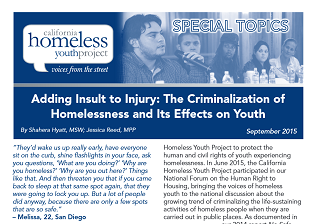I’d like to take a minute to highlight the great work of the California Homeless Youth Project. For the last several years, they have worked on assessing the needs of California’s homeless population, a notoriously difficult task to accomplish. Their 2013 report, Hidden in Plain Sight: An Assessment of Youth Inclusion in Point-in-Time Counts of California’s Unsheltered Homeless Population, remains an essential resource for anyone working on reducing the impact of homelessness in our state.
This month, the organization released another terrific report highlighting how homelessness interacts with the criminal justice system. Adding Insult to Injury: The Criminalization of Homelessness and Its Effects on Youth looks at how unaccompanied homeless youth face additional burdens due to laws that criminalize their status. For example, homeless youth are often penalized for sleeping in public places. Entering the criminal justice system at a young age can serve as a severe barrier as these youth look to lift themselves out of homelessness. A criminal record can impact their ability to find housing, secure employment, pursue education, and access some safety net resources.
The report, which is the result of interviews with and testimonials from homeless youth across the state, points out that homeless youth lack the resources needed to avoid further violating some “quality of life” laws.
This law enforcement trend is strongly influenced by “Broken Windows” theory, a concept developed in the 1980s indicating that persistent enforcement against minor offenses elevates the level of public order and reduces the occurrence of both petty and serious crimes. In practice, this has resulted in criminalizing poverty by pushing those already at the margins into a cycle of fines, debt, and jail. Despite recent national attention given to the “Broken Windows” theory, the history of criminalizing people in poverty dates back a century. Laws explicitly targeting people experiencing homelessness have primarily been enacted in the last 20 years and have accelerated pace in the last five years.
As a result of these policies, the report finds that homeless youth lack trust in law enforcement and rarely, if ever, look to the police when they need help.
Over one-third of the nation’s unaccompanied homeless youth live in California, and many are from communities of color. This resource helps shed light on one of the most pressing issues facing this community. The report concludes by offering some policy recommendations to help decriminalize homelessness, including providing more resources to homeless youth, increasing access to affordable transportation, and more. The entire report is worth checking out and if you are working on reducing homelessness in California, be sure to bookmark the California Homeless Youth Project.

